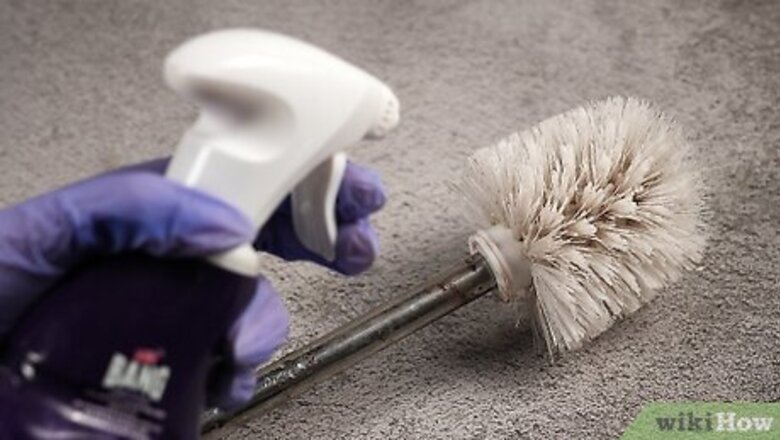
views
Spraying with Disinfectant

Spray the toilet brush thoroughly with an all-purpose disinfectant. Once you’ve cleaned your toilet, hold the toilet brush over the toilet bowl and spray it with a disinfectant of your choice. Rotate the brush as you spray to ensure every bristle gets coated in cleaner. The type of disinfectant spray is entirely up to you. You could use the same cleaner you use to clean the toilet or a squirt of hydrogen peroxide.

Place the brush handle under the toilet seat for 10 minutes. After the brush has been coated in disinfectant, shut the toilet lid on top of the brush’s handle. This will hold the brush in place over the toilet bowl so it can dry, allowing any excess disinfect to drip into the toilet. You can also dry the brush over a sink or tub. However, if you decide to do this, clean the sink and tub thoroughly afterward.

Run the brush under hot water. When the 10 minutes of drying time are up, rinse the brush in hot water to remove any lingering disinfectant, debris, and bacteria. Keep the brush under the running water until the water coming off the brush is clear. Make sure to disinfect whatever you clean the toilet brush in, such as a sink or tub. Allow the brush to dry over the toilet for another 10 minutes. Putting a wet brush back in the holder could cause mold.

Spray the brush holder with disinfectant and rinse with hot water. As you wait for the toilet brush to dry, coat the inside of the toilet brush holder with the same disinfectant you used before. Let the disinfectant soak for about 10 minutes before rinsing the holder with hot water. Place the holder on a clean towel to air-dry. Once the brush and holder are completely dry, put them back together and return them to their spot in the bathroom.
Soaking in Bleach
Add 2 to 3 capfuls of bleach to a clean toilet bowl. Clean your toilet thoroughly. Then, add around 3 capfuls of bleach to the water in the bowl. Read the back of your bleach bottle. If it gives you specific instructions about how much to use, follow them. For a deeper clean, consider filling a bucket with hot water and bleach and submerging the brush and holder in the solution.
Submerge the brush in the bleach water for 1 hour. Drop the head of the brush into the toilet bowl, being careful not to splash. Leave the brush in the bleach solution for at least 1 hour. Wear gloves and, if available, a disposable plastic apron to ensure you don’t get bleach on your skin or clothes.
Rinse the brush under hot water. Keep the brush under the water for at least 30 seconds. The hot water decomposes the active ingredient in bleach, making it safe for you to touch the bristles.
Let the brush dry completely before storing it back in the holder. Set the brush on a towel to air-dry. Don’t store it until it’s completely dry, as storing a wet or damp brush can cause bacteria to grow.
Repeat the bleaching process every month. Even if you don’t use your toilet brush that often, the brush can still host bacterial growth and collect filth. It’s a good idea to deep clean the brush monthly to prevent this.
Using Natural Products
Submerge the brush in a vinegar-water solution for 1 hour. Clean the toilet bowl, and then pour 1 cup (240 mL) of vinegar into the clean toilet water. Then, submerge the brush in the solution. Leave it in the solution for at least an hour or overnight, and then remove with gloves.

Scrub the brush with 2 grams (0.071 oz) of baking soda. Sprinkle the baking soda over the surface area of the brush. Then, use a separate cleaning brush to scrub the baking soda all over the toilet brush, making sure to get in between all the bristles. If the brush holder has stubborn stains or grime, spray it with a vinegar-water solution, sprinkle it with baking soda, and scrub it down. While this step isn’t necessary, it’s helpful to get an even deeper clean.

Run the brush under hot water. Rinse off the baking soda and grime with hot water. Make sure to keep the brush under the water for at least 30 seconds to kill any remaining bacteria.

Leave the brush out to dry before putting it away. Storing a damp or wet brush can cause bacteria and mold to grow. So, make sure it’s completely dry before storing it.
How often should you clean a toilet brush and holder?
Clean a toilet brush and holder after every use or once weekly. Experts recommend cleaning your toilet brush and holder as often as possible. The moist environment inside the holder is a breeding ground for mold and bacteria, so it’s best to clean it after every use to prevent mold from growing. If you can’t clean it after every use, aim to clean it at least once a week. A deeper clean may not be necessary after each use, so use a spray disinfectant to sanitize the brush quickly. Then, give the brush and holder a deeper clean in a bleach or vinegar solution once a month.
When should you replace a toilet brush?
Replace a toilet brush every 6 months. Most experts suggest getting a new toilet brush every 6 months; however, others argue that you can go longer if you clean it regularly. Use your best judgment on when to replace yours. If the bristles are discolored or misshaped, it’s likely time for a new brush. Keep in mind that plastic toilet brushes and holders have shorter lifespans and may need to be replaced more regularly.
General Toilet Brush Care
Keeping your toilet brush and holder clean doesn’t always have to be a chore! Follow these tips and tricks to maintain your brush and ensure it stays in the most pristine condition: Rinse the brush in clean toilet water after each use. Ensure no water is on the inside of the holder to prevent bacteria growth. Invest in a holder that keeps the brush's bristles off the bottom to prevent bent bristles and bacteria.



















Comments
0 comment